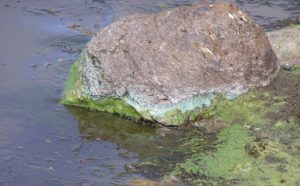
An expert on cyanobacteria says we can expect to experience more blue-green algae outbreaks as rising temperatures and fluctuating weather patterns become the new normal under climate change.
Dr. Janice Lawrence, an associate professor of biology at the University of New Brunswick who studies cyanobacteria, says we can expect to more blue-green algae outbreaks as rising temperatures and fluctuating weather patterns caused by climate change.
“Once [blue-green algae] is known to be in the environment, they don’t leave….so there isn’t much point in testing all the time. We need to use precautions, ” Dr. Janice Lawrence, an associate professor of biology at the University of New Brunswick who studies cyanobacteria told Terry Seguin on Information Morning – Fredericton recently. “We anticipate with warmer temperatures and longer summers like this that there is a greater chance that we’re going to see these organisms.”
Cyanobacteria — what we commonly call blue-green algae –– is in fact a group of bacteria that have light-harvesting pigments capable of photosynthesis. This means — unlike normal bacteria — they can harvest the sun’s energy as well as feed on decomposed biomatter, sewage runoff or nutrient-rich man-made products like fertilizers running into the water from nearby farmland.
The problem is some cyanobacteria produce toxins, and when you get enough toxic bacteria together in one place, it can become toxic enough to harm or even kill some animals.
While there are a wide number of cyanobacteria that can produce toxins, dangerous types seem to spread much more rapidly in stagnant water with warm conditions and high nutrient-loading caused by high levels of agriculture, Dr. Lawrence says.

“There might be years in a row where there is no toxicity, [but] once the organism is there, it has the potential to bloom again and to reach levels where there’s going to be a significant toxic burden.”
In Canada, research by the University of Alberta in 2012 indicated that the cyanobacterial toxin microcystin had been found in 246 water bodies in every province over the past 15 years.
Among them, Lake Winnipeg was named the Threatened Lake of 2013 by the Global Nature Fund because it had become infested with blue-green algae.
Cyanobacteria is also suspected of being the cause of death for three pet dogs that suddenly passed away immediately after playing on the edge of the Saint John river, as well as of several dogs on Vancouver Island last year.
Currently, there are 15 New Brunswick lakes reported to have been affected by cyanobacteria, including Harvey Lake, Nashwaak Lake, Grand Lake and Bathurst Lake.
Canadians aren’t alone in dealing with this waterborne menace. Currently, there are reports of blue-green algae on every continent. So far In the United States, cyanotoxins have been implicated in human and animal illness and death in at least 43 States.

In response to people asking whether the Saint John river water is safe, Dr. Lawrence had this to say:
“The toxins would have a similar effect on any vertebrates that’s exposed to them. So, frighteningly, if a dog is exposed to accumulated toxins and dies from it then a human can, too,” she said.
“However, we interact with the water quite differently. My dog rolls around, licks herself off and ingests massive amounts of water, and of course it’s going to ingest anything in that water.”
Dr. Lawrence also urged caution but not panic. She said that there is no way of telling which type of cyanobacteria is to blame or how much is needed to pose a danger without sophisticated equipment and testing.
She urges the public to wait for the government to provide a more detailed information, but don’t let it scare you away.
“I will still go rowing tomorrow on the Saint John river, but I won’t take my dog there and I won’t take my young son to play around at the waters edge. And when I come home, I will have a good shower and wash everything off and be aware there are symptoms that I would be on the lookout for.”
Recommended links:
- Let’s talk about phosphorus and blue-green algae
- Blue-green algae: here’s what you need to know
- Blue-green algae in New Brunswick lakes

